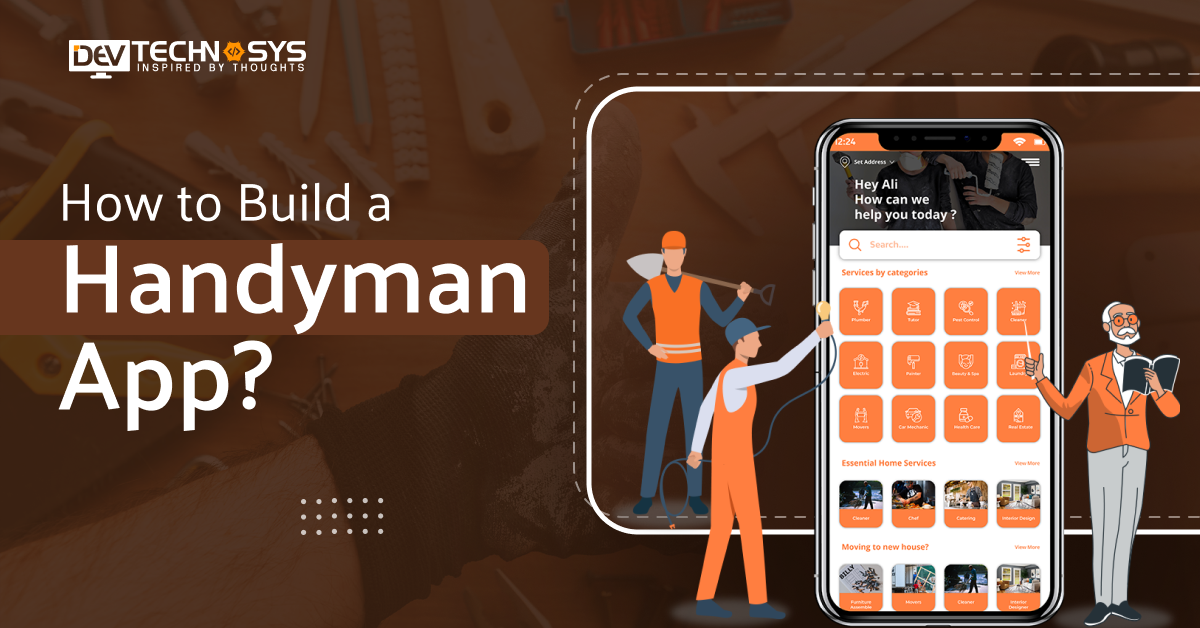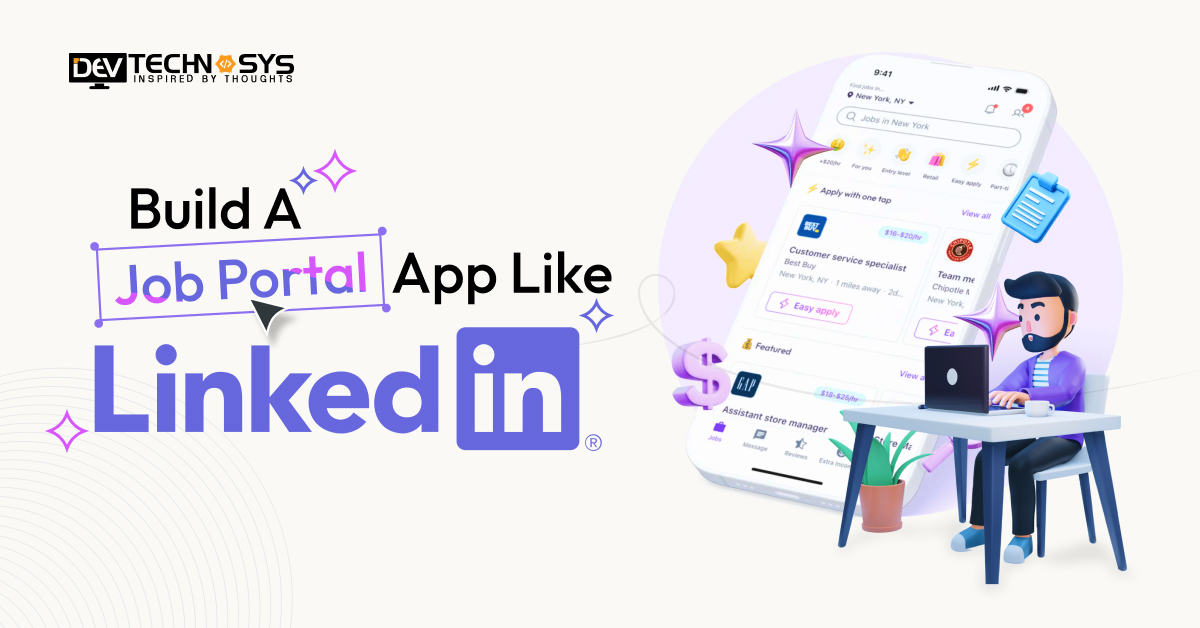The advances of technology and modernization affect everyday activities in all industries. The same applies to handyman services. On-demand handyman apps offer home-related services like renovation, painters, woodwork jobs, plumbing, and so on. It is quite comfortable to swipe the app.
With huge popularity, it is the perfect time for entrepreneurs to build a handyman app to grow their business. It is projected that the market for handyman services would grow from an estimated US$ 390.9 million in 2023 to US$ 1.8 billion by 2033.
Through 2033, the handyman services sector is expected to grow at a robust CAGR of 16.5%. This shows the demand for handyman apps will grow in the near future. So, if you are someone looking to invest in handyman app development, read this blog till the end.
It will cover the crucial steps, features, costs, benefits and other essential aspects that can help you build a handyman app.
So, let’s begin!
What is a Handyman App?
Handyman apps serve as a link between users who want handyman services and those capable of providing them. These applications may do a wide range of tasks like painting, plumbing, pest control, and cleaning. With only a few easy clicks on the screen, users may access all of the services.
Not only will homeowners profit from these applications, but handyman firms will also get their benefits. Firms may register on the platform to connect with more users by using the network to reach out to additional companies.
Thus, in order to test the feasibility to build a handyman app, you need to work with a handyman app development company.
Future Predictions & Projections of Handyman Service

Source: Statista
- It is projected that the market for handyman services would grow from an estimated US$ 390.9 million in 2023 to US$ 1.8 billion by 2033. Through 2033, the handyman services sector is expected to grow at a robust CAGR of 16.5%.
- 73% of homeowners wait to hire a handyman until their home has a number of issues before doing so.
- Approximately 4% of all handyman services clients are property managers.
- An increase in the quantity of private sector businesses, which are 72% more likely to use handyman services.
- Statistics show that 40% of US homes are at least 50 years old, while over 80% of homes are older than 20 years.
How Does a Handyman App Work?
The handyman apps connect users and professionals to offer much-needed help with these routine activities. Users find it easier to select from all of the available options for skilled and affordably priced handyman services. It is crucial to understand the operation in order to build a mobile app for handyman service.
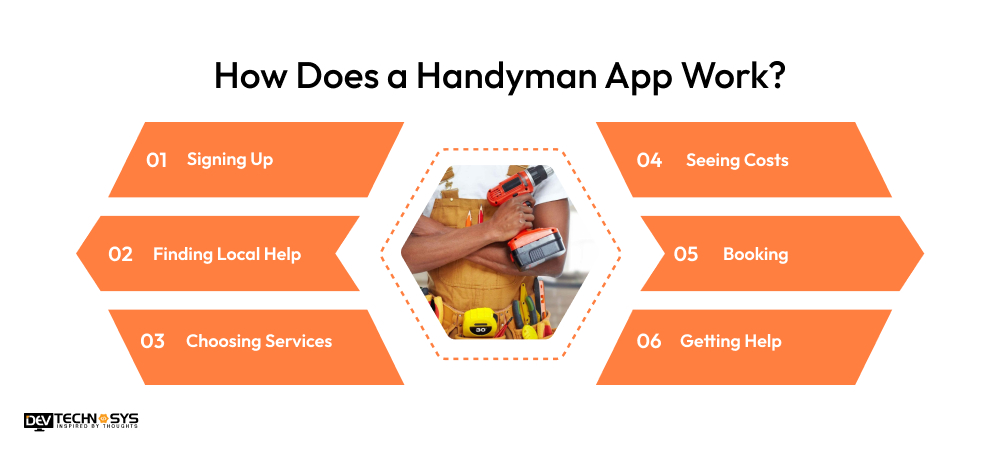
1. Signing Up
The users first register the handyman app with all the information regarding the work at hand.
2. Finding Local Help
Now, the app locates handymen in the area who can complete the task based on the user’s location.
3. Choosing Services
After that, users choose a day and time that works for them as well as the kind of assistance they want. For example, electrical or plumbing repairs.
4. Seeing Costs
Users have the option to verify the pricing of the services before making any final decisions. This aids in their decision regarding its affordability.
5. Booking
The users can proceed to schedule the handyman using the app if everything appears to be in order.
6. Getting Help
The handyman shows up at the user’s residence on the appointed day and time to do the task.
Different Types of Handyman Applications
The handyman services business has transformed along with practically every other industry due to technology. Mobile apps known as “on-demand handyman apps” link homeowners in need of repairs or maintenance to nearby handymen. So, let’s have a look at the types of handyman services.
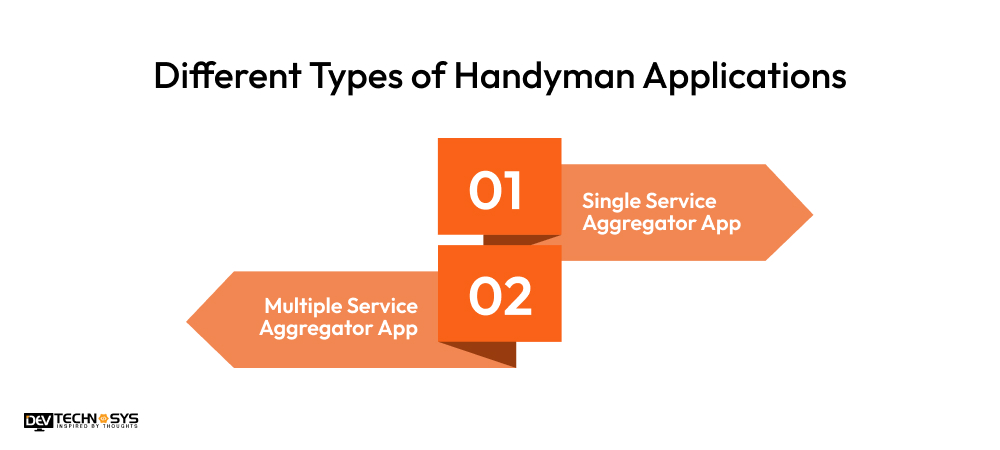
1. Single Service Aggregator App
Single-service aggregator app development solutions may be divided into two main groups. These apps, as their name suggests, are tailored to a single service. For instance, cleaning, cosmetic procedures, or auto repairs. They are simple to administer since they link experts with different specialties.
2. Multiple Service Aggregator App
These handyman applications provide a variety of services, such as carpentry, plumbing, and furniture removal, all under one convenient app. Effective management of such apps requires the involvement of numerous individuals with different areas of expertise. As such, handling them might be difficult.
Why Develop A Handyman App?
Nowadays it is quite easy to build a handyman app—a mobile platform for home services. So, why not consider the reasons for investing in handyman app development? Let’s check out:
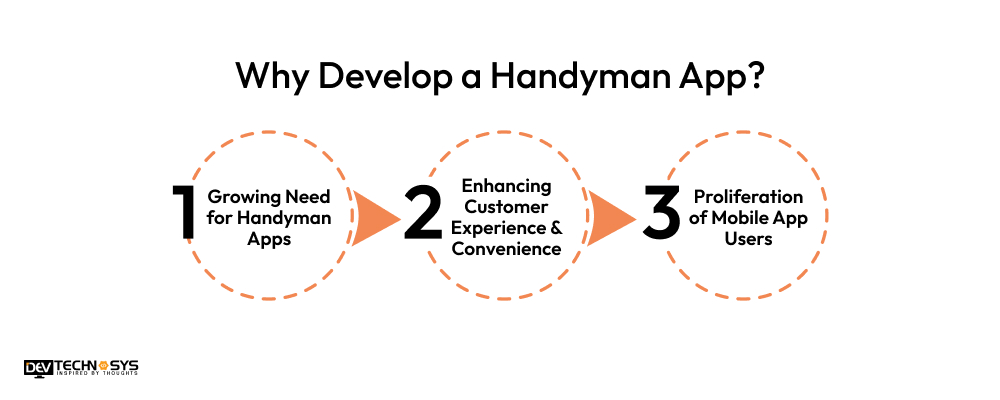
1. Growing Need for Handyman Apps
Since everything is done online these days, users are searching for experts to complete their household duties by using handyman apps like Urban Company. The handyman app industry was worth $2,638.8 million globally in 2021. By 2030, the market is expected to grow at a consistent 9.4% CAGR to reach $5,445 million. The market for on-demand handyman apps is expanding. This shows you have a sizable audience to reach and have the potential to make great money.
2. Enhancing Customer Experience & Convenience
Customers may now easily connect with qualified handyman specialists at their fingertips thanks to home service applications. They will be more satisfied as a result of this ease in the end. Additionally, apps like Airtasker have the ability to analyze user behavior, language, and interests which results in a more personalized user experience.
3. Proliferation of Mobile App Users
Having an online presence for your business has become a rewarding option due to the increasing number of smartphone users. It was projected that there would be 5 billion mobile app users worldwide in 2022. It is projected that a 23.1% rise in app users would bring the total to 6.2 billion by 2028. The handyman app has more users since there are more people using smartphones. Your chances of growing are higher the more users you have.
Step-by-Step Process To Build A Handyman App
The two most essential things you’ll need to build a handyman app are patience and an optimistic outlook. Just imagine providing customers with everything from house cleaning to groceries delivery at their fingertips. Isn’t this fascinating? So, let’s have a look at the simple steps you may take to make a handyman app:
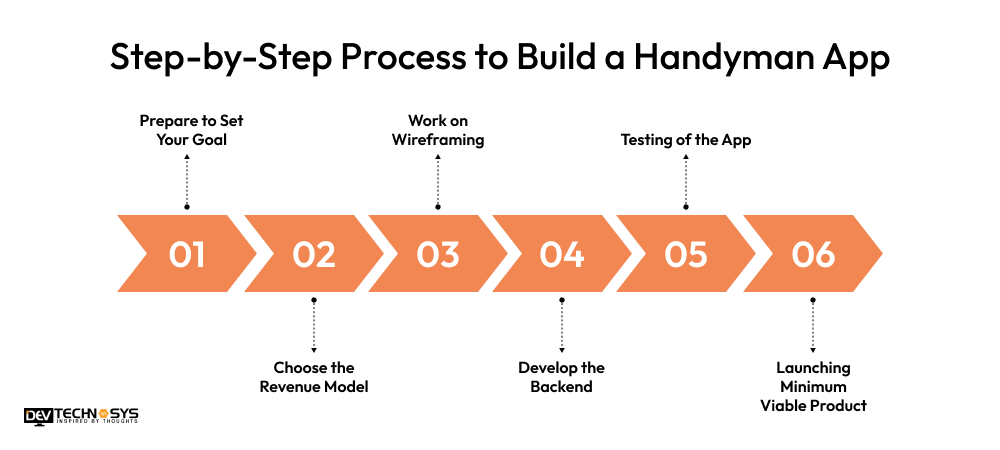
1. Prepare to Set Your Goal
Setting goals for why you need an app and what you hope to accomplish with it is the first and most crucial to build a handyman app. But it is essential to validate your app idea with an IT consulting firm. At this point, you must consider the following questions:
- How would people benefit from your app like TaskRabbit or Jobber?
- How will it address the particular problems?
- How will your app boost the user experience?
The whole plot hinges on the answers to these questions, thus it is vital to figure them out.
2. Choose the Revenue Model
It’s OK to ignore the revenue model if your intention is to release a personal app just for informative purposes. In case you want to build a handyman app for commercial use, you must choose a revenue strategy. These are a few common forms of revenue models:
- Subscription Based
- Freemium Model
- Pay Per Service
- Advertisement Model
The only thing you need to think about is efficient marketing, as any of these methods may guarantee significant revenue.
3. Work on Wireframing
WIreframing is essentially the same as sketching out a concept. It is the rough outline of the handyman app development. It is such a brilliant idea to draw out mockups of the features and elements of the application. It spares you from the last-minute modification to the design when it becomes difficult to make adjustments. The cost to develop a smart home app can add anything you forgot to include using the wireframing app.
4. Develop the Backend
After wireframing is complete, the real implementation process may be divided into two sections: front-end development and back-end development. Both need to be located and operated together for the optimal user experience. Things might get worse and you might not get the results you desire if the frontend and backend are not balanced. So, one of the on demand app development companies will write the code for the backend to build a handyman app.
5. Testing of the App
Now comes the testing phase. With the help of testers, you must follow the strict testing rules while testing the app to prevent errors even after it launches. App functionality might occasionally be harmed by what appears to be a simple problem. Thus, you should always thoroughly test your app before releasing it.
6. Launching Minimum Viable Product
Lastly, it would be preferable to release an MVP as opposed to the complete version. The MVP version of the app has all the functions you need to show off to investors or ask the compliance authority for approval. Beta testing is the primary use; this is its secondary purpose.
The logic behind this is that at times problems may still exist after testing. These may be found through beta testing, therefore MVP app development is ideal for that. To assist you in releasing an error-free version of the handyman app as the final version, real-time user feedback has also been incorporated.
Key Features of Handyman App Development
User Panel
1. Seamless Search Filter
The handyman application should have a seamless search filter. Suppose a customer is searching for a painter, then the customer should get the option to select based on location or degree of experience. This will help the user to get the desired kind of
2. Profile
On the profile page, the users can enter them Along with the details, the profile section should contain a list of major services that users would like to take regularly. This will help users to quickly go through their pre-selected services and book what is required. Online ordering app developmentneeds to be rich with features to provide convenient services to users and keep the workflow synchronized.
3. DIY Tutorials
DIY tutorials on the application will help customers to closely know how are they going to get services. This would build trust among customers and assure them of great service. If you find it difficult to include such features, you can contact mobile app developers for hire.
4. Service List
In a user app, list all the home services that your company It is difficult to remember and choose each service one by one but easier to navigate through listed services.
5. Scheduling and Cancellation Of Appointment
The application should have the feature of scheduling as well as cancellation of the appointment. It allows users to book the slot whenever they get time. The cancellation feature is necessary because sometimes users due to other emergencies might have to cancel the appointment at the last moment.
A calendar should help users looking forward to booking multiple appointments for different services. An app helps to make service simple for its users. So, the Handyman application should have the features that make it enjoyable, engaging, and convenient.
6. Login Page
Applications give the flexibility to collect users’ information and data. These data can be further used to improve business by offering customized services. Handyman applications should allow users to get access to the app via Facebook or email.
7. AR–based Paint Tester and Measurement Tool Integration
AR or Augmented Reality technology is one of the most innovative and immersive technologies that make the life of consumers as well as businesses easier. AR allows placing the computer-generated object in users’ surroundings and gives it a real-like You can connect to mobile app developers for hireto integrate such features.
Users can use this feature to select the exact paint color that would suit the house. AR measuring tape helps to virtually measure accurate dimensions. This increases the efficiency and accuracy of service leading to a satisfied customer.
8. GPS Tracking
Customers love to track their service providers while they are on the way. This feature builds transparency among customers and businesses. It increases the engagement of your app. Users can know the real-time location and expect the time of arrival with the help of GPS tracking. The GPS trackers will help owners to track the activities of service providers as well.
9. Push Notifications
Push notifications help remind users about an upcoming appointment or monthly appointments that need to be booked. You can notify users about upcoming offers and the addition of new services. It increases the engagement of the application. Personalized push notifications cultivate a healthy relationship with customers.
10. Payment Gateway Integration
Many times, on an on-location store, you might have to bargain with customers leading to an unpleasant experience. But in the case of on-demand service, the charge is fixed and online payment makes the process hassle-free.
You can hire dedicated developers and include different payment modes to make it convenient for customers. The payment gateway helps users as well as owners to keep track of payment records. It increases the sense of security among service providers and businesses.
11. How Does the App Work?
A home service app targets a wide range of audiences. Users are of different age groups varying from millennials to senior citizens. Some might find difficulty in navigating different sections of the handyman application. ‘How does the app work?’ feature will help the user to guide through navigating the app making the process smoother for users.
12. Contact Us
Hire dedicated developersto add the contact us feature. Contact us is a necessary feature to help the user resolve their queries. Users should not have unsolved queries which might lead to disappointment.
13. Reviews
The user should be allowed to add reviews after availing of the services. Review plays a key role in improving services and applications. Positive reviews build a positive reputation for the business making the business more profitable.
Service Provider Panel
- Login And Account: The login feature similar to the user app is mandatory. It allows service providers to add their details that you might require ahead. Apart from basic details, service providers can add their education, work experience, and can manage their profile as well.
- Job Request: The job request feature will help the provider confirm the appointment that users want. They can have a look throughout the list of requested jobs.
- Track Order: This feature allows to track all the previous orders and feed the details of users and the services they requested for. Service providers can easily keep count of their services through this feature.
- Active Orders: This feature will give statistics of all accepted orders and show the time of appointment.
- Add Services: This feature is important as sometimes after reaching the users’ home, the user might ask for more services. In such scenarios, they can quickly add additional services and charges accordingly. Laundry app development services are high in-demand.
Admins Panel
- Bookings: Admin can check the booking and schedules of service providers. This will help to keep track of their doings. Admin can go through the complete details of a booking.
- Users: Admin app must be connected with the users and service providers. It allows the admin to control all the activities and manage profiles. Admin should be able to easily track the services of service providers.
- Reviews: Admin should be able to go through all reviews and manage them. This feature allows the admin to make changes accordingly.
- Customer Details: This feature added by the mobile app development company fetches the admin with complete details of customers who have booked the services.
5 Best Handyman Apps That Rock
Before you build a handyman app, you must be well-versed with the competitor apps. So, it’s time to quickly review the top handyman apps of 2024 to see what users find most appealing about these apps.
| Top Handyman Apps | Available Platform | Downloads | Ratings |
| Taskrabbit | Android | iOS | 1M+ | 3.6 |
| Jobber | Android | iOS | 500K+ | 3.4 |
| Urban Company | Android | iOS | 10M+ | 4.7 |
| Thumbtack | Android | iOS | 1M+ | 4.8 |
| Handy | Android | iOS | 500K+ | 3.0 |
Challenges & Solutions of Handyman App Development
When you build a handyman app, you could also run into common challenges that you must solve. As you get started on your handyman app development journey, we’ve covered a few challenges and potential handyman solutions that you know and stay on track with.
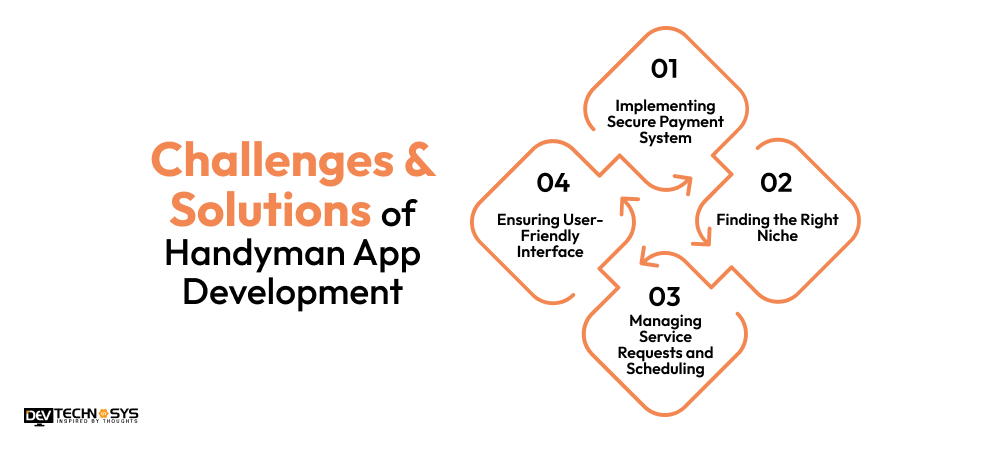
1. Challenge: Implementing Secure Payment System
An effective and safe payment mechanism is essential for a handyman app. Consumers ought to feel secure making payments because they know that their financial data is secure.
Solution: Select a reliable payment gateway that complies with PCI DSS and other industry requirements. To safeguard user data, put strong security measures in place. Examples include encryption and frequent security assessments.
2. Challenge: Finding the Right Niche
The handyman sector is large and offers a broad range of services. To focus on, developers must choose a narrow specialty. This might include everything from installations to house repairs to specialist services like electrical or plumbing work.
Solution: To determine the need for various on-demand handyman services app development services in your target location, conduct in-depth market research. Think about things like area trends, population demographics, and the availability of comparable services.
3. Challenge: Managing Service Requests and Scheduling
A good handyman app must handle service requests and appointment scheduling effectively. Mobile app developers for hire must design a system that makes it simple for clients to make reservations and for service providers to efficiently manage their calendars.
Solution: Provide a user-friendly scheduling platform that enables clients to indicate their requirements, select times that work for them, and get reminders when their appointments are ready. Set up a calendar-based scheduling system so that providers can keep track of their reservations and make the most of their time.
4. Challenge: Ensuring User-Friendly Interface
Even for anyone without technical expertise, a handyman app needs to be simple to utilize and simple. The user interface needs to be neat, orderly, and eye-catching.
Solution: You must give the user experience top priority when you develop an app like Jobber or other. Make use of legible labeling, user-friendly navigation, and eye-catching design features. Test the use of the product to find any issues and fix them.
How Much Does It Cost To Build A Handyman App?
Now you must be thinking about the cost to build an on demand handyman app. Well, it relies on your project requirement like how complex the app you want. So it is quite complex to determine the exact amount. But we will provide a rough estimation on on-demand home service app development cost. The Handyman mobile app development cost $10000-$25000 or beyond. Let’s take a look at the below table:
| App Complexity | Cost Estimations |
| Simple Handyman App | $10000-$15000 |
| Medium Handyman App | $15000-$20000 |
| Complex Handyman App | $25000+ |
Besides, you can calculate the handyman app development cost with the below formula:
Total Handyman App Development Cost = Developer’s Rate * Development Time
Now you know the cost to develop a handyman app like Jobber or Taskrabbit, it is time to consult with a mobile app development company. But let’s first get to know the importance of budget.
Why Is It Important to Fix the Budget for Your Project?
Now you are well-versed with the cost to build a handyman app, it is vital to be more specific about the budget. Fixing a budget for your handyman mobile app development helps you know the entire planning structure and take the correct measures. So, before you start the development project, just remember the following factors.

1. Helps Identify the Actual Needs
By setting a budget to develop your handyman app, you can anticipate the needs of the end users and provide them with what they need at the moment. This way, you can easily decide on features to develop a plumbing service app and make informed decisions.
2. Helps in Market Research
As soon as you sit down to set your budget, you have to go out there and do extensive market research to figure out what the standards are.
3. You Need the MVP
The MVP is essential for successfully navigating meetings with potential investors. Therefore, it is crucial to establish a budget to comprehend the financial and temporal requirements associated with developing an MVP.
4. Need To Save for Marketing
It is unwise to assume that your efforts and expenses conclude with the app’s development. Numerous stages follow the development phase. The challenges of deploying the app, marketing it effectively, and ensuring it reaches the intended audience are significant. While you may estimate an on-demand handyman app development cost, it is the expenses incurred post-development that play a crucial role in determining the app’s success.
How To Monetize Your Handyman App?
Just think you have created a beautiful handyman app. Now what? Obviously, you need a precise revenue model. But there are multiple monetization models, so you need to carefully choose the best among all. So, we have jotted down some models that many giants like Taskrabbit, Jobber etc. have utilized. Let’s have a look at them:
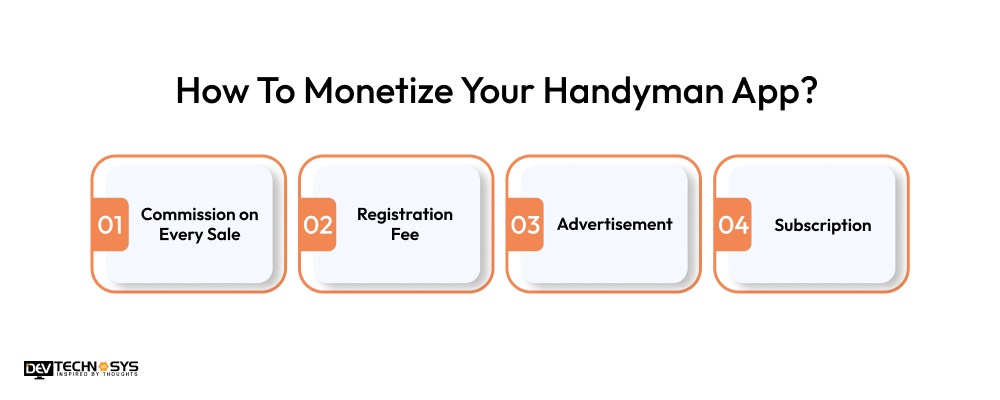
1. Commission on Every Sale
The on-demand handyman applications use this as one of their common business methods. You have the ability to designate a certain percentage that will be deducted by the service providers from each sale that completes successfully on the platform.
Apps like Taskrabbit, are acknowledged as their main revenue stream. 15% of the entire sum paid to the tasker is charged by the application. You might also use a comparable model in your application. In the early going, you can try to charge professionals as little as possible for registering on the site.
2. Registration Fee
Upon their initial login to the application, service providers are required to remit a specific fee. For instance, an app like TaskRabbit, a well-known handyman application, imposes a non-refundable registration fee of $25 on its taskers.
This registration fee, often referred to as a sign-up fee, is a common practice in marketplace business models. It necessitates a one-time flat payment from vendors to gain access to the platform. Consequently, sellers are only obligated to make this payment once, allowing them to operate freely within the marketplace thereafter.
3. Advertisement
The advertising space within your mobile application concepts can serve as a potential revenue stream. The home service industry encompasses not only skilled labor but also a range of tools, materials, and equipment. Users and service providers may require these products at different intervals.
Consequently, you have the opportunity to feature advertisements for these items, facilitating easy purchases for customers. This approach will benefit manufacturers while allowing you to earn a commission on each sale generated through your application.
4. Subscription
You have the option to offer your app like Jobber at no cost to users while imposing a monthly or annual service fee on the taskers. As the number of taskers on your platform increases, you are likely to encounter greater revenue potential. The subscription model enables businesses to predict revenue with greater precision and allocate resources towards enhancing customer retention and satisfaction strategies.
Planning to Create A Handyman App Within Your Budget?
Now that you know the process to build a handyman app, it’s time to spend money on handyman app development. The initial steps in determining an idea is to analyze the budget, business needs, and target market.
However, the mobile app development team is better equipped to understand these aspects of your project. Dev Technosys is the best on demand app development company partner of choice when designing your handyman app development solution.
You get an expert group of professional developers, testers, and analysts who can boost the likelihood of your new concept discovery being validated. So, what are you waiting for? Share your project requirements with us and we will build a handyman app within your budget.
FAQs
1. How Much Does It Cost To Develop A Handyman App?
The cost to build a handyman app depends on numerous factors and your project requirement. The mobile app development cost you somewhere around $10000-$25000. It is best to consult with a handyman service app development company.
2. How Long Does It Take To Create A Handyman App?
The time to build a handyman app will be between 2-8 months. It is not the same as always but can vary depending on your project size. So, it is best to consult with a Handyman app development services provider about the actual time.
3. What Are the Benefits of Handyman App Development?
The handyman app development benefits you will get are mentioned below:
- Cost-effective service
- Customizability
- Reliability
- Scalability
- Accessibility
4. How To Build A Handyman App?
To make a handyman app like Taskrabbit, you need to follow the below steps:
- Conduct market research
- Know your competitors
- Create a feature list
- Design a user interface
- Develop the backend infrastructure
- Test and launch the app
- Maintain and market the app
5. What Are the Top Handyman Apps?
There are multiple handyman applications in the market. Let’s have a look at them:
- Taskrabbit
- Urban Company
- Handy
- Jobber
- Thumbtack
